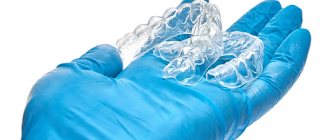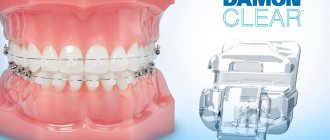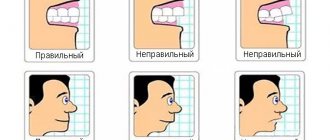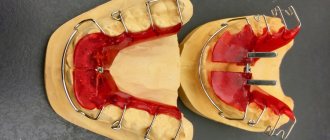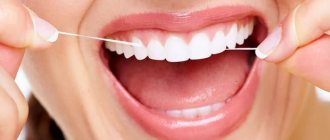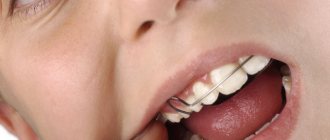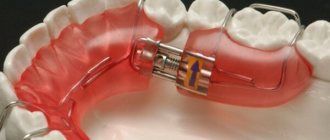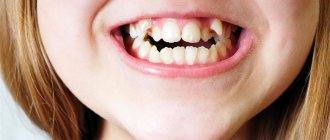Many people hesitate to get braces because they are unsightly. At the same time, they need to be worn for quite a long time - from several months to 2-3 years. Today, the problem of the aesthetics of orthodontic structures is easily solved: with the help of colorless or transparent braces. Let's find out what they look like and what they are.
In this article
- What do clear braces look like?
- Colorless braces: types and features
- Clear plastic braces
- Clear ceramic braces
- Transparent sapphire braces
- Alternative to clear braces
- Hygiene with braces
Wearing braces is the most effective method of treating malocclusion pathologies, which is suitable for almost all people, regardless of the condition of the teeth, age and other factors. Braces are a complex orthodontic structure consisting of many small parts: locks, screws, springs, arches, etc. If they are installed on the outside of the dentition, it is almost impossible to hide them. This is especially true for metal braces.
The aesthetic defect that structures create is one of the main reasons for a person’s refusal of orthodontic treatment. You have to wear braces for a long time: from 6 months to 2-3 years. It will not be possible to hide the presence of staples in the oral cavity from others during this entire time. However, you can still make them less noticeable. For this purpose, colorless or transparent braces are used. Let's tell you why they are called that.
What do clear braces look like?
Braces are made from various materials, including transparent and colorless. They are almost invisible when a person speaks or smiles. In other words, such braces are designed to hide the very fact of orthodontic treatment from other people. However, it is worth understanding that there are no such systems that are completely invisible if they are on the outside of the teeth.
Any orthodontic structure consists of dozens of elements. Locks, screws and other parts that are attached to tooth enamel can be made transparent or colorless. The arc of braces is always metal. She is the one who performs the main bite correction. It is not possible to refuse its installation. But it can be disguised. To make it less noticeable, it is painted white. In such cases, it becomes more aesthetic. However, it cannot be called absolutely invisible: upon closer examination, any interlocutor will notice it, even if he does not look closely.
It is possible to completely hide orthodontic treatment from others. For this purpose, lingual structures and aligners are used. But first, let's talk about transparent braces: their types, advantages and disadvantages.
How is the installation going?
Installation work takes place in several stages. A good dentist takes impressions to make control models in order to further monitor the progress of bite treatment. Then he installs special separation rings that slightly move the teeth apart. The doctor applies an etching gel to the areas where the clear braces are located. After a certain time, it is washed off and the enamel is dried. Then a fixing adhesive bond is applied, which is illuminated with a photopolymer lamp. Glue is also applied to each bracket, after which the orthodontist accurately determines the position of the transparent element, pressing it to the tooth. After the specialist fixes all the braces, he will insert an arch into their grooves, which he will secure with transparent ligatures (rubber bands).
Sapphire braces are much more difficult to fix than metal ones, since they almost merge with the surface of the tooth. Therefore, such systems should be installed only by experienced specialists with extensive practical experience working with transparent orthodontic structures.
Colorless braces: types and features
There are several types of braces that appear clear or colorless:
- plastic;
- ceramic;
- sapphire.
The choice of orthodontic design is limited by medical indications and financial capabilities of the patient. There are cases when it is impossible for a person to get plastic braces, for example, in case of severe malocclusion. Then he can opt for ceramic or sapphire designs. If you don’t have enough money for them, you will have to wear metal braces. Let's describe each variety in more detail.
What types of braces are there? How long does the installation procedure take? How long should you wear them?
Before invisible braces can be installed, they must be ordered. The production time depends on the manufacturer and type of lingual braces: if you choose standard braces, you will have to wait about 2 weeks for them while the indirect fixation tray is made; if you choose custom braces, it will take 4-6 weeks until they are manufactured and brought from Germany.
What is the difference between custom invisible braces and standard ones?
Individual braces allow you to track the final position of the teeth, that is, see the final picture. Also, the treatment procedure is reduced to 18 months, whereas standard invisible braces must be worn for 2 years. Of course, this mostly depends on the specific situation and only a doctor can give you more detailed dates during the examination. Installing invisible braces is a fairly labor-intensive procedure and takes about 3 hours. After installation, you will also need to visit your doctor periodically to check and adjust the system.
Clear plastic braces
For the manufacture of plastic transparent braces, special high-quality plastic is used, which can be used in dentistry. Such designs are suitable for both teenagers and adults. Children are especially sensitive to the attention of their peers, so plastic braces are an ideal option for them. Firstly, they can be transparent, that is, almost invisible. Secondly, there are multi-colored models with locks in green, red, yellow, purple or blue. They look fun and stylish, and most importantly - much more attractive than metal products.
Let us list the main advantages of plastic brace systems:
- Aesthetics. The color of the plastic matches the enamel, and is therefore invisible to others.
- Large selection of multi-colored models. This is especially true for teenagers: if it is difficult to make braces invisible, you can make them beautiful and stylish.
- Convenience. A person wearing plastic braces feels more comfortable than wearing metal ones. In addition, the teeth and oral mucosa get used to them faster: plastic braces are lightweight and do not put as much pressure on the dentition as other types of orthodontic structures.
- Low cost. Plastic models are much cheaper than other types of braces.
Plastic structures also have disadvantages:
- They are not suitable for correcting severe malocclusions.
- They darken quickly if you do not follow hygiene rules and diet.
- More fragile and more likely to fail than metal ones.
- It takes longer to correct bite pathology.
Additionally, clear plastic braces are not lingual. They are installed only on the outside of the teeth. If such designs are contraindicated for the patient, and the aesthetic component is important for him, he will have to make a choice in favor of ceramic or sapphire braces.
Aligners - the most transparent orthodontic system
Both ceramic and sapphire braces can only be called transparent. Of course, if you compare them with a metal system, the aesthetics will be much higher. But only Invisalign aligners are truly transparent; they are practically invisible to others even at close range. This is a set of completely transparent removable trays, which the patient independently changes every two weeks.
At the PROPRICUS clinic, experienced orthodontist Natalya Sergeevna Ivanova installs aligners. They always receive rave reviews from patients. All our specialists were trained by the number 1 doctor in the Invisalign rating - Nana Gezalova. We are the only clinic in Moscow that successfully treats with aligners all bite pathologies that braces can handle.
Clear ceramic braces
Ceramic braces are marketed as transparent, but in reality they are more colorless. Sometimes they acquire a slight yellowish or beige tint. Such structures are made from polycrystalline ceramics and aluminum oxide. The doctor can choose a material that imitates the natural color of tooth enamel. The braces will adapt to its shade, becoming almost invisible. However, you can still see them, they are just not as catchy as metal or plastic multi-colored systems.
The main advantages of ceramic braces include the following points:
- There are many shades of ceramics, among which you can choose a model for a specific patient.
- They are resistant to dyes, therefore they do not limit a person’s consumption of coffee, tea and other drinks with dyes.
- They do not cause allergic reactions, as often happens when wearing metal structures.
- Bite pathologies are corrected faster compared to plastic models.
Disadvantages of ceramic systems include:
- They are more expensive than metal and plastic ones.
- They treat pathology longer than metal braces.
- Destroyed during dismantling.
Ceramic staples are also more fragile than metal ones. If a person plays sports and there is a risk of damage to the structure, it is better to install products made of metal or sapphire.
Installation of invisible braces in St. Petersburg
Transparent braces are universal designs for straightening teeth without aesthetic discomfort during treatment. In St. Petersburg, services for the elimination of bite defects using aesthetic orthodontic products are provided on favorable terms by the doctors of the Smile Factor.
Patients are provided with only original designs from trusted manufacturers. A personal treatment plan is drawn up for each patient. A variety of models allows you to choose the ones that suit you in terms of price, appearance and results.
Make an appointment with Smile Factor, take advantage of professional services and get straight teeth and an aesthetic smile.
Transparent sapphire braces
Sapphire braces are made from sapphire, obtained artificially in the laboratory. It is much inferior to natural stone in terms of strength, but is superior to other orthodontic systems in this parameter. In addition, sapphire braces are almost invisible. They have the highest aesthetic properties.
List all the advantages of sapphire braces:
- Hypoallergenic. Sapphire is biocompatible with oral tissues, so the likelihood of developing allergies is minimal.
- Fast adaptation. Sapphire braces do not interfere with diction and do not rub the mucous membrane. Getting used to them occurs within a few days.
- High strength. Such structures are resistant to mechanical stress. You can play sports in them.
- The highest aesthetic standards. Sapphire braces are almost invisible. In addition, they do not change their external properties under the influence of food with dyes.
The only disadvantage of such systems is their high cost. Sapphire braces will cost 2-3 times more than metal or plastic structures.
What to choose
Each of the described brace systems allows you to effectively combat malocclusion, both mild and complex types. As for the choice, it is difficult to single out just one type of design. There are a number of factors that need to be taken into account, one of which is price.
If you adhere to the opinion of doctors, then they recommend sapphire and ceramic braces that are not visible. But objectively, lingual products are the best. Despite the fact that they have a very high cost, today they are preferred by those patients who are constantly in contact with people. If what is more important to you is not appearance, but convenience, then you should opt for sapphire designs.
Alternative to clear braces
Transparent braces made of plastic, ceramic and sapphire can be replaced with conventional metal structures that are installed on the inside of the teeth. Such orthodontic systems are called lingual. Unlike other braces, they are completely invisible.
However, such staples also have disadvantages:
- not suitable for all malocclusion pathologies;
- greatly complicate hygiene procedures.
In some cases, if there is a medical reason for this, the orthodontist may offer the patient aligners (aligners) - orthodontic devices made of plastic and silicone used to correct the bite. They are a plate that is put on the teeth for a certain time. This device corrects the bite by applying pressure to the jaws, just like braces, but the plates are changed periodically to increase the load on the dentition. During treatment, the patient can change several dozen aligners, it all depends on the severity of the pathology.
The aligners are completely transparent, so it is almost impossible to notice them on another person’s teeth. In addition, the aligners can be removed if necessary, for example, before important negotiations or a date.
There are other advantages of aligners: they can be removed before meals, they are easy to care for, there is almost no need to get used to them, etc. But mouth guards are prescribed only for minor bite defects, as well as at the last stage of orthodontic treatment, that is, after removing braces to consolidate the result of therapy.
Price
An important factor when choosing a particular method of correcting a bite is the cost of treatment. Of course, no professional can accurately estimate the final amount that a patient will have to pay for several years of wearing braces. This is due to the fact that the price is formed from many factors; it depends on the frequency of visits to the doctor and the identification of design defects. However, the approximate cost can still be announced:
- Plastic. For installation of the system on one jaw, the bill can be from 20,000 rubles and more.
- Ceramics. Domestic brands will cost a little less than foreign ones. For installation of Smart braces on one row you will pay from 50,000 rubles. More well-known options, for example, from the American manufacturer Ortho, will cost at least 70,000 rubles. per row. At the same time, ligature options cost less.
- Sapphire. Classic devices can cost from 75,000 rubles. and more. Self-ligating ones will cost much more, but the results from their use will be more obvious and faster.
Hygiene with braces
It is impossible to maintain the aesthetic appeal of braces throughout the entire treatment period without following the rules of hygiene. After installation of orthodontic appliances, you will have to brush your teeth more often and for longer than usual. In addition, you will need to buy additional hygiene products. Among them:
- Toothbrush with V-shaped bristles (CURAPROX Ortho).
- Mono-beam brush (CURAPROX 1006 Single & Sulcular).
- Brush (Hager & Werken Miradent Pic Brush Refills Pink).
- Rinses and balms (DRC ROCS “Active calcium”).
- Dental floss (Miradent Mirafloss implant chx).
- Irrigator with attachment for braces (Revyline RL100, Panasonic EW-1411).
You also need to remember your diet. To reduce the risk of damage to the structure and deterioration of its aesthetic properties, it is necessary to avoid solid foods, sweets, sticky foods and a number of other products.
Before purchasing brushes, dental floss, irrigators and other hygiene products, consult your doctor.
Unique lingual braces
This system is very different from all the others - the design in this case is installed not on the front side of the teeth, as many are used to, but on the back, inner side. This method makes braces completely invisible to others and allows you to appear in public without embarrassment. The principle of their operation is the same as that of conventional braces - pressure is applied to the teeth in the right places using special locks and a metal arch, which is why they smoothly realign and take the correct position. The only difference is the moment of installation and adjustment - braces are not only invisible to others, but also difficult to access for the orthodontist himself, who has to work almost by touch when working. Their fastening requires a lot of experience and skill of the doctor, which significantly affects the cost: lingual braces are the most expensive of all. In addition, leading brands make them from a special gold-based alloy, which gives the system elasticity and, as a result, reliability and durability.
Invisible lingual braces are made individually - the orthodontist examines the patient's dentition, makes an impression, on the basis of which a design is then created. Then it is placed taking into account the structural features of the human jaw. On average, development and, as a result, the waiting period take about one month. But it should be remembered that due to their location and inaccessibility, such braces are very difficult to care for. For personal hygiene, it is necessary to use additional brushes, brushes and irrigators to help remove stuck food particles.
Pros:
- invisible to others
- reliable and durable
— created taking into account the individual characteristics of the patient
Minuses:
- high price
- significant impairment of diction when using
- long adaptation period
- difficult care and difficult personal hygiene
Diet
While wearing ceramic braces, a person should review their diet and limit the consumption of certain foods. Due to the fact that ceramics is a fairly fragile material, you should not put a sharp load on the structure and eat hard foods - these include nuts, crackers, apples. This food can cause the braces to break and come off.
It is advisable to cross off food that stretches and can stick to the surface of your teeth from your shopping list. Toffees, some candies, chewing gum, fresh flour products, dried fruits, corn flakes, chips can remain in the spaces between the components of the structure, increasing the risk of pathogenic bacteria joining and the development of a pathological process. Also, these products can dislodge the structure, which will be an important reason for going to the dental office.
Sweets and foods high in carbohydrates are temporarily excluded from the diet - their fragments can remain between the elements of braces and tooth enamel, increasing the risk of plaque, tartar and carious lesions.
Whether it is possible to drink coffee drinks while wearing ceramic braces is a controversial issue. It is believed that ceramics are resistant to food dyes, but in the absence of high-quality oral hygiene, the accumulation of pieces of food in the teeth, the resulting plaque can absorb pigments and thereby affect the change in shade of the structure. The same goes for smoking. This is not prohibited, but it is advisable to minimize such exposure.
You should not eat too hot or too cold food - firstly, this negatively affects the enamel of the teeth, and secondly, it can lead to loss of structure properties.
After installing the brace system, it is recommended to eat food that contains large amounts of magnesium, calcium, vitamins A, B, C, D, fruits and vegetables, soups, purees, and dairy products.
Aligners
Aligner trays are made from special types of silicone with high transparency and specially specified parameters of flexibility and elasticity. They are removable systems that must be removed during every meal and brushing of teeth. In addition, they also need to be cleaned from time to time using toothpaste. Their main advantages over other systems are high elasticity, efficiency and comfort. They are able to follow the contours of your gums and teeth as accurately as possible, so you will not experience any discomfort when wearing them.
The best braces for adults
Treatment of malocclusion in adults takes longer and is more difficult than in children. Therefore, the choice of braces must be approached with special care. The following criteria are important:
- — severity of the defect;
- - general condition of teeth;
- — aesthetics;
- — convenience;
- - price;
- - strength;
- - expected duration of treatment.
There is no particular braces system that could be considered the best. Different orthodontic structures are suitable for each clinical case. If you are most interested in aesthetics, you should get lingual braces. In cases where you need a cheaper option, classic metal systems are suitable. Moreover, regardless of the situation, doctors usually recommend installing self-ligating structures, because This will reduce the number of appointments with the orthodontist, and they are also more effective.
Contraindications
The procedure for installing ceramic braces has a number of contraindications, which can be relative or absolute:
- The first group includes caries, non-compliance with the rules of personal oral hygiene, hypersensitivity and allergic reactions to the material of the structure being installed, and dental diseases of inflammatory origin. When treating the above ailments, wearing braces may be allowed - this issue should be decided by your attending physician.
- Conditions in which it is strictly forbidden to carry out this procedure are the absence of healthy teeth that will support braces and can withstand all the stress, diseases of the blood, immune, endocrine system, tuberculosis, damage to the bone apparatus.
Plastic, ceramic or artificial sapphire?
The most affordable are plastic braces that blend with the teeth. Their clasps are made of dental plastic, selected to match the natural shade of the patient’s tooth enamel. They have a metal groove in which the orthodontic arch slides with minimal friction, due to which the teeth are aligned quite quickly.
But such braces have several significant disadvantages. Due to the low strength of plastic, they quickly wear out and chip and easily change the chosen shade under the influence of artificial and natural dyes contained in drinks and foods.
They were replaced by even less noticeable, but more expensive and therefore installed in installments ceramic braces. They are divided into two subgroups, look approximately the same, differing in appearance only in the degree of transparency, and in color they turn out to be completely identical to tooth enamel.
- The first subgroup includes braces with clasps made of matte, partially opaque polycrystalline ceramics. Dentists call them ceramic braces.
- The second category includes the best aesthetic braces made from transparent ceramic single crystals. These are the most invisible and most expensive systems that ideally mask the treatment process and thus fully justify the financial costs.
